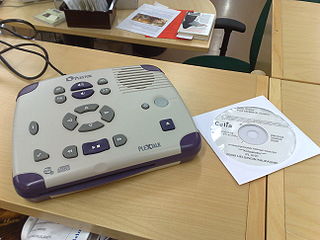
The Internet Archive is an American digital library founded on May 10, 1996, and chaired by free information advocate Brewster Kahle. It provides free access to collections of digitized materials including websites, software applications, music, audiovisual and print materials. The Archive also advocates for a free and open Internet. As of January 1, 2023, the Internet Archive holds more than 38 million print materials, 11.6 million pieces of audiovisual content, 2.6 million software programs, 15 million audio files, 4.7 million images, 251,000 concerts, and over 832 billion web pages in its Wayback Machine. Their mission is to provide "universal access to all knowledge."

The Library of Congress National Digital Library Program (NDLP) is assembling a digital library of reproductions of primary source materials to support the study of the history and culture of the United States. The NDLP brought online 24 million books and documents from the Library of Congress and other research institutions.

Digitization is the process of converting information into a digital format. The result is the representation of an object, image, sound, document, or signal obtained by generating a series of numbers that describe a discrete set of points or samples. The result is called digital representation or, more specifically, a digital image, for the object, and digital form, for the signal. In modern practice, the digitized data is in the form of binary numbers, which facilitates processing by digital computers and other operations, but digitizing simply means "the conversion of analog source material into a numerical format"; the decimal or any other number system can be used instead.
In library and archival science, digital preservation is a formal endeavor to ensure that digital information of continuing value remains accessible and usable. It involves planning, resource allocation, and application of preservation methods and technologies, and it combines policies, strategies and actions to ensure access to reformatted and "born-digital" content, regardless of the challenges of media failure and technological change. The goal of digital preservation is the accurate rendering of authenticated content over time. The Association for Library Collections and Technical Services Preservation and Reformatting Section of the American Library Association, defined digital preservation as combination of "policies, strategies and actions that ensure access to digital content over time." According to the Harrod's Librarian Glossary, digital preservation is the method of keeping digital material alive so that they remain usable as technological advances render original hardware and software specification obsolete.

Digital accessible information system (DAISY) is a technical standard for digital audiobooks, periodicals, and computerized text. DAISY is designed to be a complete audio substitute for print material and is specifically designed for use by people with "print disabilities", including blindness, impaired vision, and dyslexia. Based on the MP3 and XML formats, the DAISY format has advanced features in addition to those of a traditional audio book. Users can search, place bookmarks, precisely navigate line by line, and regulate the speaking speed without distortion. DAISY also provides aurally accessible tables, references, and additional information. As a result, DAISY allows visually impaired listeners to navigate something as complex as an encyclopedia or textbook, otherwise impossible using conventional audio recordings.
The National Digital Information Infrastructure and Preservation Program (NDIIPP) of the United States was an archival program led by the Library of Congress to archive and provide access to digital resources. The program convened several working groups, administered grant projects, and disseminated information about digital preservation issues. The U.S. Congress established the program in 2000, and official activity specific to NDIIPP itself wound down between 2016 and 2018. The Library was chosen because of its role as one of the leading providers of high-quality content on the Internet. The Library of Congress has formed a national network of partners dedicated to preserving specific types of digital content that is at risk of loss.

In conservation, library and archival science, preservation is a set of preventive conservation activities aimed at prolonging the life of a record, book, or object while making as few changes as possible. Preservation activities vary widely and may include monitoring the condition of items, maintaining the temperature and humidity in collection storage areas, writing a plan in case of emergencies, digitizing items, writing relevant metadata, and increasing accessibility. Preservation, in this definition, is practiced in a library or an archive by a conservator, librarian, archivist, or other professional when they perceive a collection or record is in need of maintenance.
Oral history preservation is the field that deals with the care and upkeep of oral history materials, whatever format they may be in. Oral history is a method of historical documentation, using interviews with living survivors of the time being investigated. Oral history often touches on topics scarcely touched on by written documents, and by doing so, fills in the gaps of records that make up early historical documents.
The term born-digital refers to materials that originate in a digital form. This is in contrast to digital reformatting, through which analog materials become digital, as in the case of files created by scanning physical paper records. It is most often used in relation to digital libraries and the issues that go along with said organizations, such as digital preservation and intellectual property. However, as technologies have advanced and spread, the concept of being born-digital has also been discussed in relation to personal consumer-based sectors, with the rise of e-books and evolving digital music. Other terms that might be encountered as synonymous include "natively digital", "digital-first", and "digital-exclusive".
Preservation metadata is item level information that describes the context and structure of a digital object. It provides background details pertaining to a digital object's provenance, authenticity, and environment. Preservation metadata, is a specific type of metadata that works to maintain a digital object's viability while ensuring continued access by providing contextual information, usage details, and rights.
Digital artifactual value, a preservation term, is the intrinsic value of a digital object, rather than the informational content of the object. Though standards are lacking, born-digital objects and digital representations of physical objects may have a value attributed to them as artifacts.
PREservation Metadata: Implementation Strategies (PREMIS) is the de facto digital preservation metadata standard.
Music librarianship is the area of librarianship that pertains to music collections and their development, cataloging, preservation and maintenance, as well as reference issues connected with musical works and music literature. Music librarians often have degrees in both music and librarianship. Music librarians deal with standard librarianship duties such as cataloging and reference, which become more complicated when music scores and recordings are involved. Therefore, music librarians generally read music and have at least a basic understanding of both music theory and music history to aid in their duties.
A digital library, also called an online library, an internet library, a digital repository, a library without walls, or a digital collection, is an online database of digital objects that can include text, still images, audio, video, digital documents, or other digital media formats or a library accessible through the internet. Objects can consist of digitized content like print or photographs, as well as originally produced digital content like word processor files or social media posts. In addition to storing content, digital libraries provide means for organizing, searching, and retrieving the content contained in the collection. Digital libraries can vary immensely in size and scope, and can be maintained by individuals or organizations. The digital content may be stored locally, or accessed remotely via computer networks. These information retrieval systems are able to exchange information with each other through interoperability and sustainability.

The International Association of Sound and Audiovisual Archives (IASA) was established in 1969 to serve as a forum for international co-operation between archives, libraries, and individuals interested in the preservation of recorded sound and audiovisual documents.
A data management plan or DMP is a formal document that outlines how data are to be handled both during a research project, and after the project is completed. The goal of a data management plan is to consider the many aspects of data management, metadata generation, data preservation, and analysis before the project begins; this may lead to data being well-managed in the present, and prepared for preservation in the future.
DigitalNZ is a service run by the National Library of New Zealand and funded by the New Zealand Government hosting New Zealand-related digital media. The service is searchable and shareable, and reuse is allowed where possible. As of 2019 there were more than 30 million digital items from more than 200 organisations, fully searchable and free to access. Partner organisations include libraries, museums, galleries, government departments, the media and community groups. Content includes photographs, videos, artworks, news reports and audio recordings. It aims to be the "simplest public website through which people can access reliable New Zealand material". Metadata is structured and made available via an API which is free to use.
The Council on Library and Information Resources (CLIR) is an American independent, nonprofit organization. It works with libraries, cultural institutions, and higher learning communities on developing strategies to improve research, teaching, and learning environments. It is based in Alexandria, VA, United States. CLIR is supported primarily by annual dues from its over 180 sponsoring institutions and 190 DLF members, and by foundation grants and individual donations.

The Indiana University Archives of Traditional Music holds over 100,000 individual audio and video recordings across over 3500 collections of field, broadcast, and commercial recordings. Its holdings are primarily focused on audiovisual recordings relating to research in the academic disciplines of ethnomusicology, folklore, anthropology, linguistics, and various area studies.







